In-Depth Report on Risk Management Policy and Procedure Analysis
VerifiedAdded on 2023/06/16
|11
|2528
|217
Report
AI Summary
This report outlines a comprehensive risk management policy and procedure, emphasizing the importance of health and safety in the workplace. It defines key terms such as risk, likelihood, consequence, and risk control, and establishes principles for health and safety risk management. The report details a consultation process and communication tools for engaging with workers, a WHS management framework, and a four-step risk management procedure including hazard identification, risk assessment, risk control, and review control. It also references relevant standards and legislative requirements, a monitoring and review process, and methods for ensuring the effectiveness of controls. The ultimate goal is to prevent harm to staff, clients, and guests by systematically managing risks and promoting a safe working environment. Desklib provides access to this and many other solved assignments.
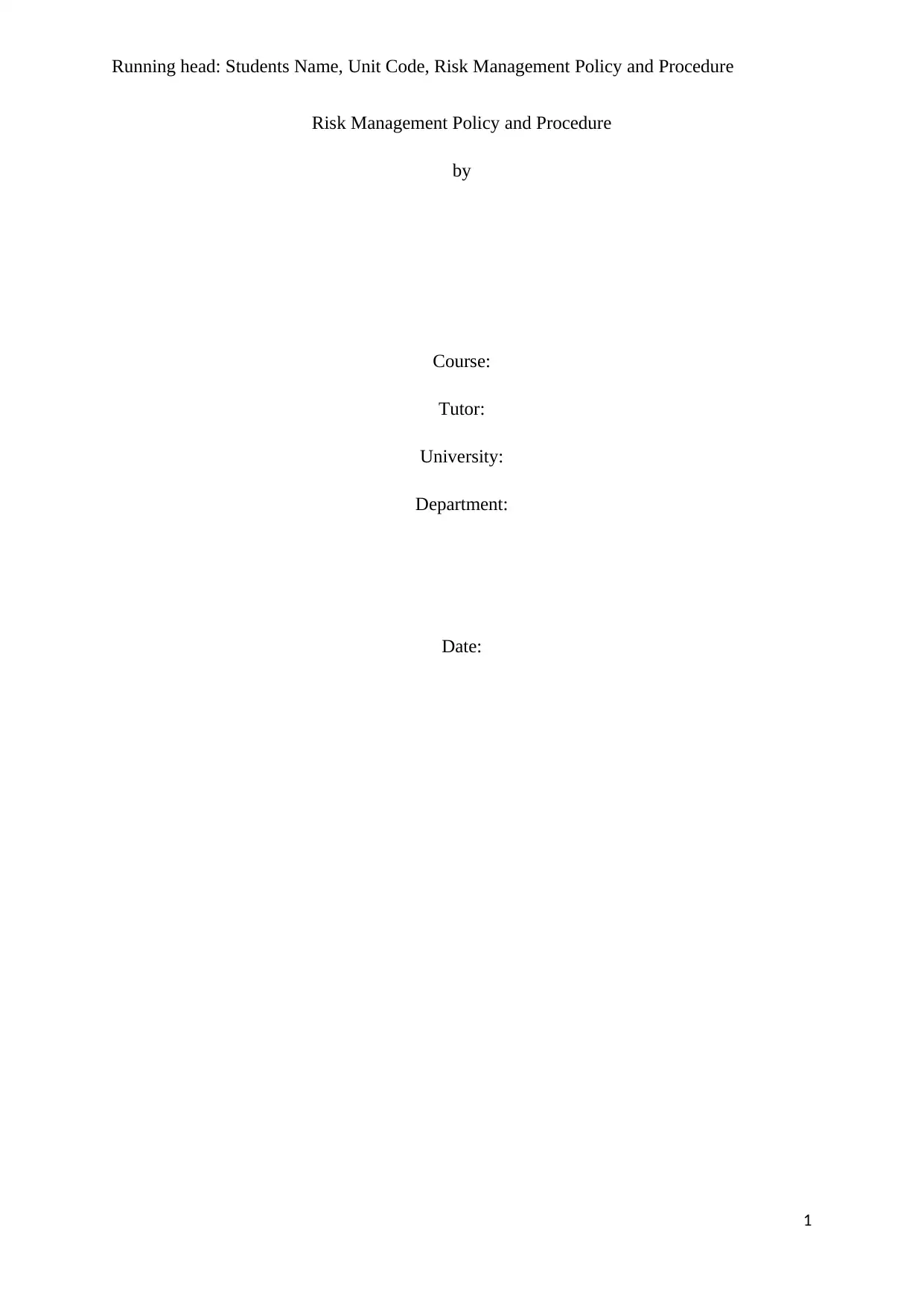
Running head: Students Name, Unit Code, Risk Management Policy and Procedure
Risk Management Policy and Procedure
by
Course:
Tutor:
University:
Department:
Date:
1
Risk Management Policy and Procedure
by
Course:
Tutor:
University:
Department:
Date:
1
Secure Best Marks with AI Grader
Need help grading? Try our AI Grader for instant feedback on your assignments.

Students Name, Unit Code, Risk Management Policy and Procedure
Table of Contents
1.0 Purpose.................................................................................................................................3
2.0 Scope....................................................................................................................................3
3.0 Definitions............................................................................................................................3
4.0 Principles of Health and Safety Risk Management..............................................................4
5.0 Consultation Process and Communication Tools with workers..........................................4
6.0 WHS Management Framework............................................................................................5
7.0 Risk Management Procedures..............................................................................................6
Step 1: Hazard identification..................................................................................................6
Step 2: Risk Assessment.........................................................................................................6
Step 3: Risk Control...............................................................................................................6
Step 4: Review Control..........................................................................................................7
8.0 Standards and Legislative Requirements.............................................................................7
9.0 Monitoring and Review Process..........................................................................................8
10.0 Ensuring Effectiveness of controls.....................................................................................8
References..................................................................................................................................9
2
Table of Contents
1.0 Purpose.................................................................................................................................3
2.0 Scope....................................................................................................................................3
3.0 Definitions............................................................................................................................3
4.0 Principles of Health and Safety Risk Management..............................................................4
5.0 Consultation Process and Communication Tools with workers..........................................4
6.0 WHS Management Framework............................................................................................5
7.0 Risk Management Procedures..............................................................................................6
Step 1: Hazard identification..................................................................................................6
Step 2: Risk Assessment.........................................................................................................6
Step 3: Risk Control...............................................................................................................6
Step 4: Review Control..........................................................................................................7
8.0 Standards and Legislative Requirements.............................................................................7
9.0 Monitoring and Review Process..........................................................................................8
10.0 Ensuring Effectiveness of controls.....................................................................................8
References..................................................................................................................................9
2
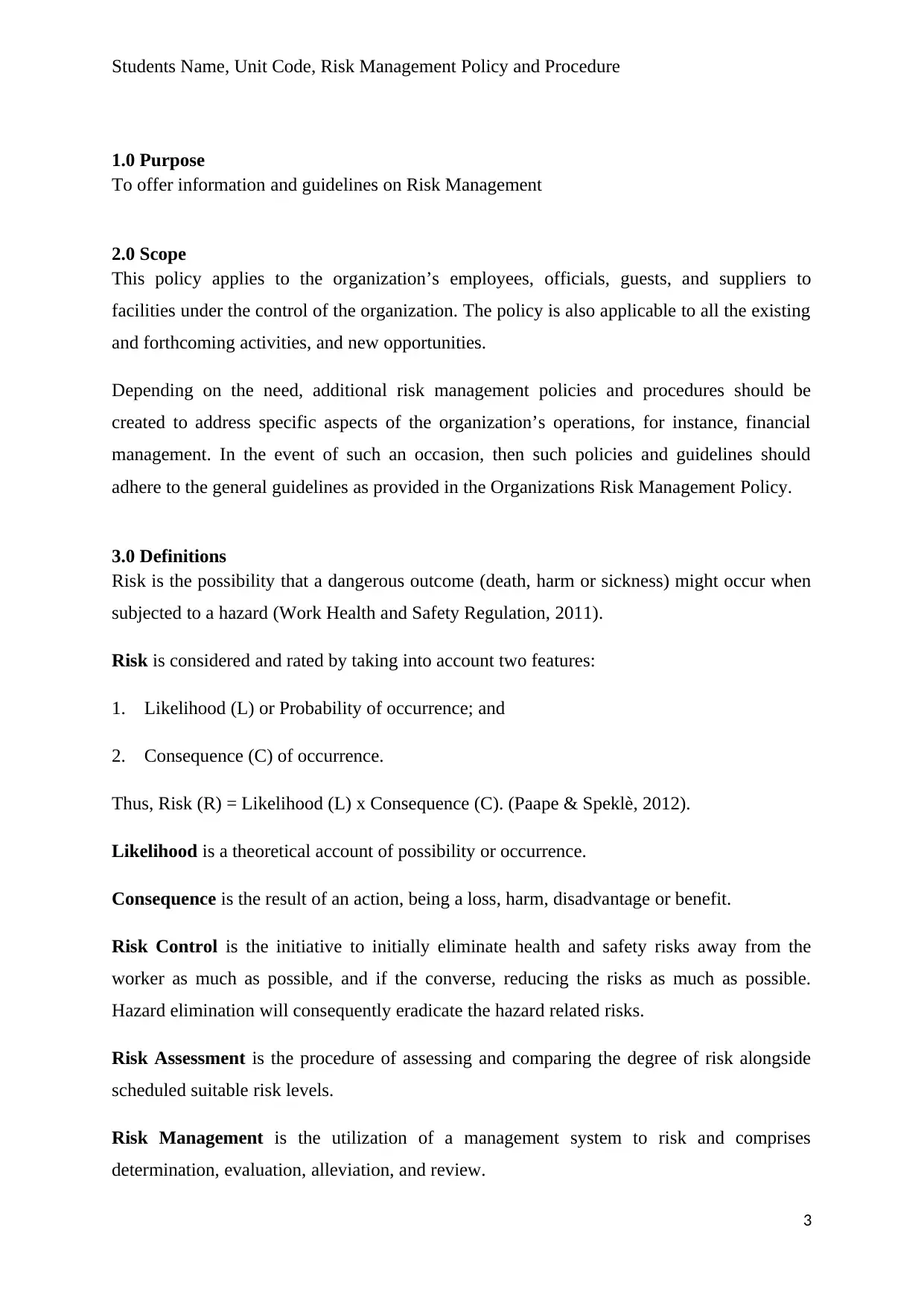
Students Name, Unit Code, Risk Management Policy and Procedure
1.0 Purpose
To offer information and guidelines on Risk Management
2.0 Scope
This policy applies to the organization’s employees, officials, guests, and suppliers to
facilities under the control of the organization. The policy is also applicable to all the existing
and forthcoming activities, and new opportunities.
Depending on the need, additional risk management policies and procedures should be
created to address specific aspects of the organization’s operations, for instance, financial
management. In the event of such an occasion, then such policies and guidelines should
adhere to the general guidelines as provided in the Organizations Risk Management Policy.
3.0 Definitions
Risk is the possibility that a dangerous outcome (death, harm or sickness) might occur when
subjected to a hazard (Work Health and Safety Regulation, 2011).
Risk is considered and rated by taking into account two features:
1. Likelihood (L) or Probability of occurrence; and
2. Consequence (C) of occurrence.
Thus, Risk (R) = Likelihood (L) x Consequence (C). (Paape & Speklè, 2012).
Likelihood is a theoretical account of possibility or occurrence.
Consequence is the result of an action, being a loss, harm, disadvantage or benefit.
Risk Control is the initiative to initially eliminate health and safety risks away from the
worker as much as possible, and if the converse, reducing the risks as much as possible.
Hazard elimination will consequently eradicate the hazard related risks.
Risk Assessment is the procedure of assessing and comparing the degree of risk alongside
scheduled suitable risk levels.
Risk Management is the utilization of a management system to risk and comprises
determination, evaluation, alleviation, and review.
3
1.0 Purpose
To offer information and guidelines on Risk Management
2.0 Scope
This policy applies to the organization’s employees, officials, guests, and suppliers to
facilities under the control of the organization. The policy is also applicable to all the existing
and forthcoming activities, and new opportunities.
Depending on the need, additional risk management policies and procedures should be
created to address specific aspects of the organization’s operations, for instance, financial
management. In the event of such an occasion, then such policies and guidelines should
adhere to the general guidelines as provided in the Organizations Risk Management Policy.
3.0 Definitions
Risk is the possibility that a dangerous outcome (death, harm or sickness) might occur when
subjected to a hazard (Work Health and Safety Regulation, 2011).
Risk is considered and rated by taking into account two features:
1. Likelihood (L) or Probability of occurrence; and
2. Consequence (C) of occurrence.
Thus, Risk (R) = Likelihood (L) x Consequence (C). (Paape & Speklè, 2012).
Likelihood is a theoretical account of possibility or occurrence.
Consequence is the result of an action, being a loss, harm, disadvantage or benefit.
Risk Control is the initiative to initially eliminate health and safety risks away from the
worker as much as possible, and if the converse, reducing the risks as much as possible.
Hazard elimination will consequently eradicate the hazard related risks.
Risk Assessment is the procedure of assessing and comparing the degree of risk alongside
scheduled suitable risk levels.
Risk Management is the utilization of a management system to risk and comprises
determination, evaluation, alleviation, and review.
3

Students Name, Unit Code, Risk Management Policy and Procedure
Risk Owner is the individual(s) in charge of managing risks and is typically the individual
unswervingly in charge of the strategy, activity or action that is associated with the risk.
4.0 Principles of Health and Safety Risk Management
Risk management is a significant administrative and organizational function.
The organization is predetermined in its methodology to risk management, weighs the risk
management costs alongside the expected gains, and embarks on contingency planning in the
event of realization of dire risks (Marcelino-Sádaba et al., 2014; NSW Health, 2016).
It is the fundamental duty of the organization to safeguard the health and safety of its
employees and any other person while at work. The duty of ensuring health and safety
demands that the organization manages risks (Gallagher & Underhill, 2012).
By removing health and safety risks away as much as is possible; and
If contrariwise to remove the risks, by reducing those risks as much as is
reasonably practicable.
The determination of that which is ‘reasonably practicable’ to safeguard individuals from
injury demands balancing of given issues, such as the possibility of risk taking place and the
level of injury that would be as a result, and then deciding on the reasonable action based on
the situations. (Protecting People and Property, n.d; AS/NZS ISO 31000:2009).
Effective risk management comprises:
A commitment to health and safety from the Board of Directors of the
organization
The integration and collaboration of the employees of the organization
5.0 Consultation Process and Communication Tools with workers
Employee consultation alongside their representatives is a must in each stage of the process
of risk management. Based on the expertise, knowledge, and information of its employees, it
is possible for the identification of all hazards and the most effective risk controls chosen
(Chapman, 2011; NSW Treasury, 2012).
4
Risk Owner is the individual(s) in charge of managing risks and is typically the individual
unswervingly in charge of the strategy, activity or action that is associated with the risk.
4.0 Principles of Health and Safety Risk Management
Risk management is a significant administrative and organizational function.
The organization is predetermined in its methodology to risk management, weighs the risk
management costs alongside the expected gains, and embarks on contingency planning in the
event of realization of dire risks (Marcelino-Sádaba et al., 2014; NSW Health, 2016).
It is the fundamental duty of the organization to safeguard the health and safety of its
employees and any other person while at work. The duty of ensuring health and safety
demands that the organization manages risks (Gallagher & Underhill, 2012).
By removing health and safety risks away as much as is possible; and
If contrariwise to remove the risks, by reducing those risks as much as is
reasonably practicable.
The determination of that which is ‘reasonably practicable’ to safeguard individuals from
injury demands balancing of given issues, such as the possibility of risk taking place and the
level of injury that would be as a result, and then deciding on the reasonable action based on
the situations. (Protecting People and Property, n.d; AS/NZS ISO 31000:2009).
Effective risk management comprises:
A commitment to health and safety from the Board of Directors of the
organization
The integration and collaboration of the employees of the organization
5.0 Consultation Process and Communication Tools with workers
Employee consultation alongside their representatives is a must in each stage of the process
of risk management. Based on the expertise, knowledge, and information of its employees, it
is possible for the identification of all hazards and the most effective risk controls chosen
(Chapman, 2011; NSW Treasury, 2012).
4
Secure Best Marks with AI Grader
Need help grading? Try our AI Grader for instant feedback on your assignments.
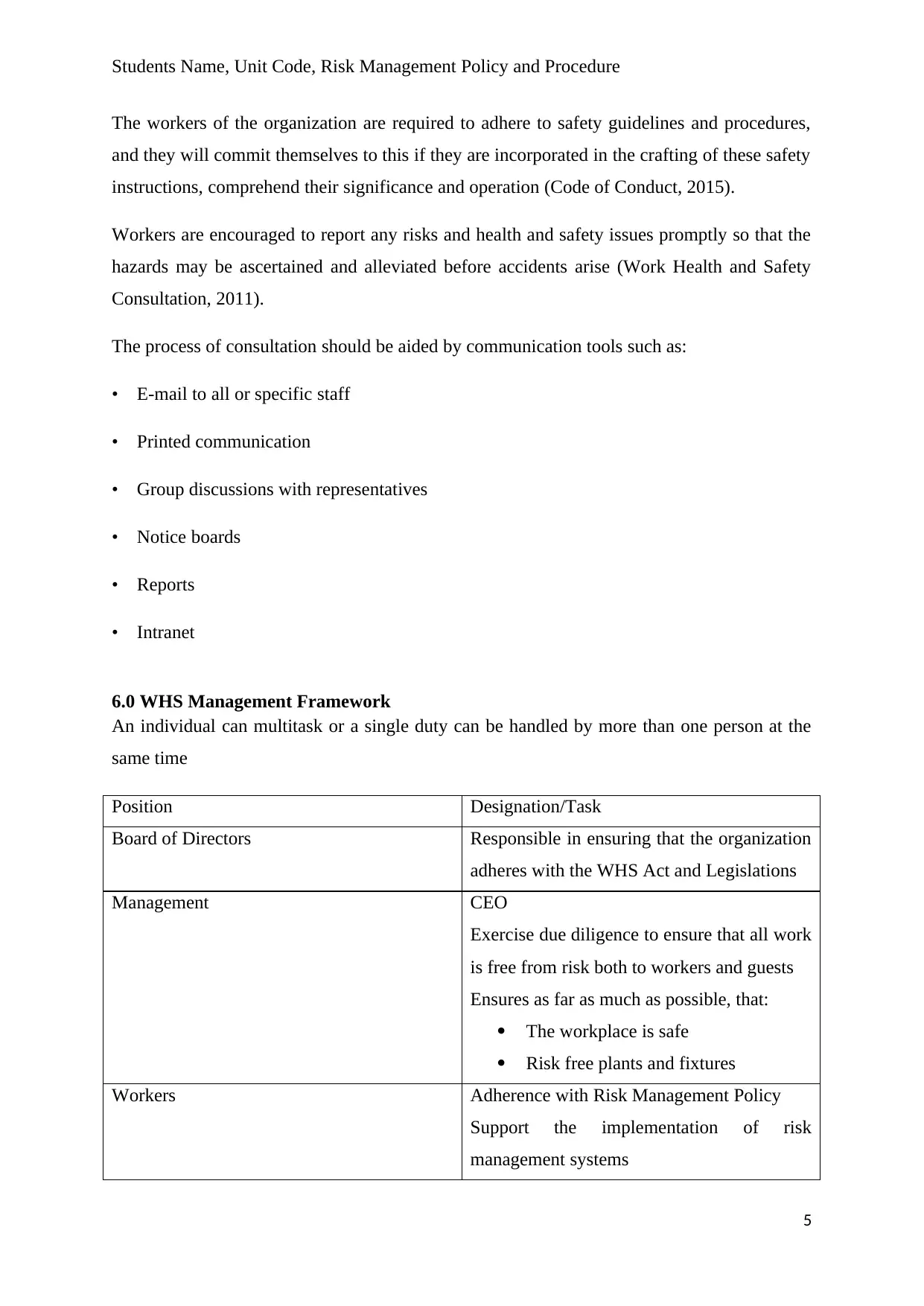
Students Name, Unit Code, Risk Management Policy and Procedure
The workers of the organization are required to adhere to safety guidelines and procedures,
and they will commit themselves to this if they are incorporated in the crafting of these safety
instructions, comprehend their significance and operation (Code of Conduct, 2015).
Workers are encouraged to report any risks and health and safety issues promptly so that the
hazards may be ascertained and alleviated before accidents arise (Work Health and Safety
Consultation, 2011).
The process of consultation should be aided by communication tools such as:
• E-mail to all or specific staff
• Printed communication
• Group discussions with representatives
• Notice boards
• Reports
• Intranet
6.0 WHS Management Framework
An individual can multitask or a single duty can be handled by more than one person at the
same time
Position Designation/Task
Board of Directors Responsible in ensuring that the organization
adheres with the WHS Act and Legislations
Management CEO
Exercise due diligence to ensure that all work
is free from risk both to workers and guests
Ensures as far as much as possible, that:
The workplace is safe
Risk free plants and fixtures
Workers Adherence with Risk Management Policy
Support the implementation of risk
management systems
5
The workers of the organization are required to adhere to safety guidelines and procedures,
and they will commit themselves to this if they are incorporated in the crafting of these safety
instructions, comprehend their significance and operation (Code of Conduct, 2015).
Workers are encouraged to report any risks and health and safety issues promptly so that the
hazards may be ascertained and alleviated before accidents arise (Work Health and Safety
Consultation, 2011).
The process of consultation should be aided by communication tools such as:
• E-mail to all or specific staff
• Printed communication
• Group discussions with representatives
• Notice boards
• Reports
• Intranet
6.0 WHS Management Framework
An individual can multitask or a single duty can be handled by more than one person at the
same time
Position Designation/Task
Board of Directors Responsible in ensuring that the organization
adheres with the WHS Act and Legislations
Management CEO
Exercise due diligence to ensure that all work
is free from risk both to workers and guests
Ensures as far as much as possible, that:
The workplace is safe
Risk free plants and fixtures
Workers Adherence with Risk Management Policy
Support the implementation of risk
management systems
5
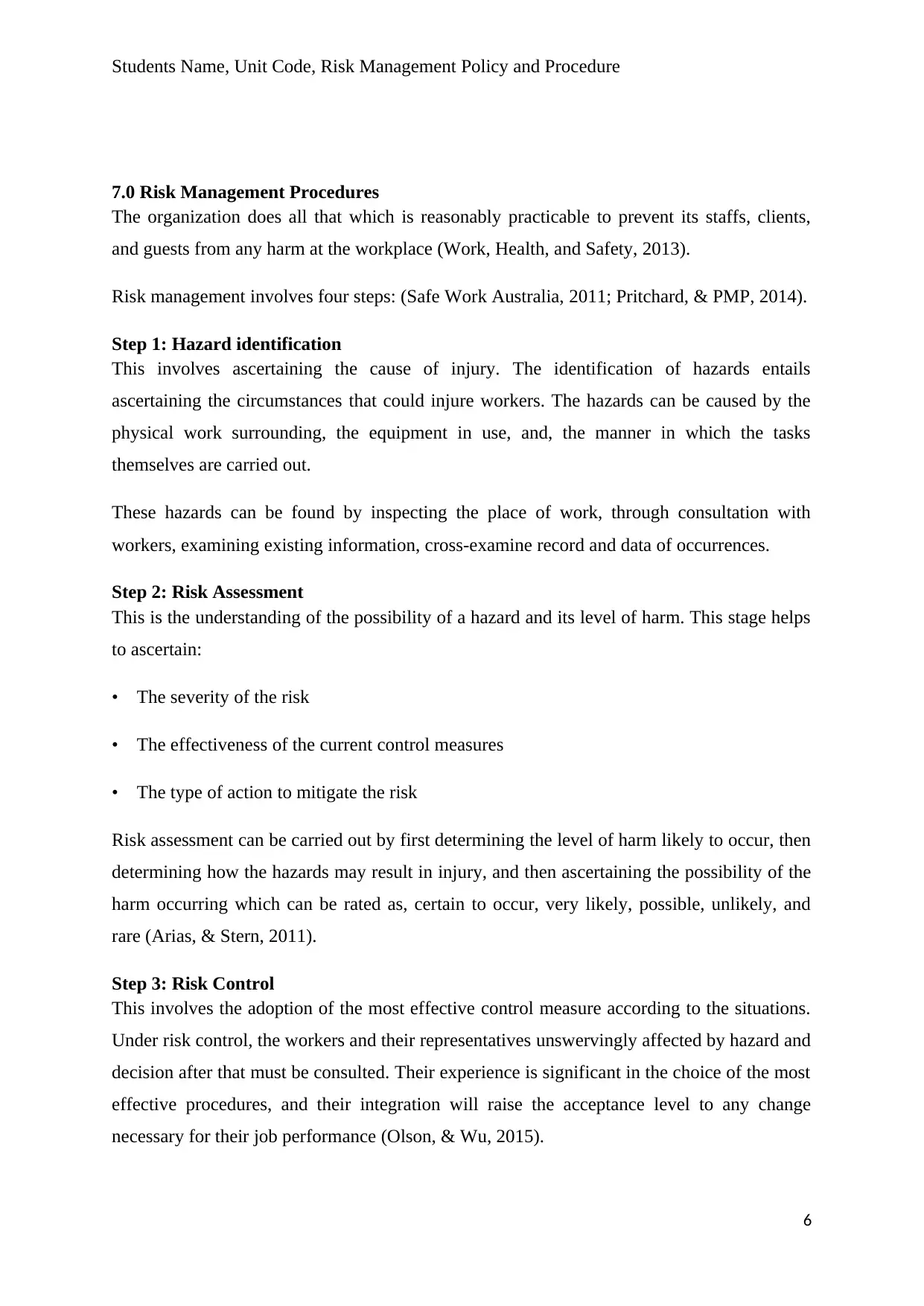
Students Name, Unit Code, Risk Management Policy and Procedure
7.0 Risk Management Procedures
The organization does all that which is reasonably practicable to prevent its staffs, clients,
and guests from any harm at the workplace (Work, Health, and Safety, 2013).
Risk management involves four steps: (Safe Work Australia, 2011; Pritchard, & PMP, 2014).
Step 1: Hazard identification
This involves ascertaining the cause of injury. The identification of hazards entails
ascertaining the circumstances that could injure workers. The hazards can be caused by the
physical work surrounding, the equipment in use, and, the manner in which the tasks
themselves are carried out.
These hazards can be found by inspecting the place of work, through consultation with
workers, examining existing information, cross-examine record and data of occurrences.
Step 2: Risk Assessment
This is the understanding of the possibility of a hazard and its level of harm. This stage helps
to ascertain:
• The severity of the risk
• The effectiveness of the current control measures
• The type of action to mitigate the risk
Risk assessment can be carried out by first determining the level of harm likely to occur, then
determining how the hazards may result in injury, and then ascertaining the possibility of the
harm occurring which can be rated as, certain to occur, very likely, possible, unlikely, and
rare (Arias, & Stern, 2011).
Step 3: Risk Control
This involves the adoption of the most effective control measure according to the situations.
Under risk control, the workers and their representatives unswervingly affected by hazard and
decision after that must be consulted. Their experience is significant in the choice of the most
effective procedures, and their integration will raise the acceptance level to any change
necessary for their job performance (Olson, & Wu, 2015).
6
7.0 Risk Management Procedures
The organization does all that which is reasonably practicable to prevent its staffs, clients,
and guests from any harm at the workplace (Work, Health, and Safety, 2013).
Risk management involves four steps: (Safe Work Australia, 2011; Pritchard, & PMP, 2014).
Step 1: Hazard identification
This involves ascertaining the cause of injury. The identification of hazards entails
ascertaining the circumstances that could injure workers. The hazards can be caused by the
physical work surrounding, the equipment in use, and, the manner in which the tasks
themselves are carried out.
These hazards can be found by inspecting the place of work, through consultation with
workers, examining existing information, cross-examine record and data of occurrences.
Step 2: Risk Assessment
This is the understanding of the possibility of a hazard and its level of harm. This stage helps
to ascertain:
• The severity of the risk
• The effectiveness of the current control measures
• The type of action to mitigate the risk
Risk assessment can be carried out by first determining the level of harm likely to occur, then
determining how the hazards may result in injury, and then ascertaining the possibility of the
harm occurring which can be rated as, certain to occur, very likely, possible, unlikely, and
rare (Arias, & Stern, 2011).
Step 3: Risk Control
This involves the adoption of the most effective control measure according to the situations.
Under risk control, the workers and their representatives unswervingly affected by hazard and
decision after that must be consulted. Their experience is significant in the choice of the most
effective procedures, and their integration will raise the acceptance level to any change
necessary for their job performance (Olson, & Wu, 2015).
6
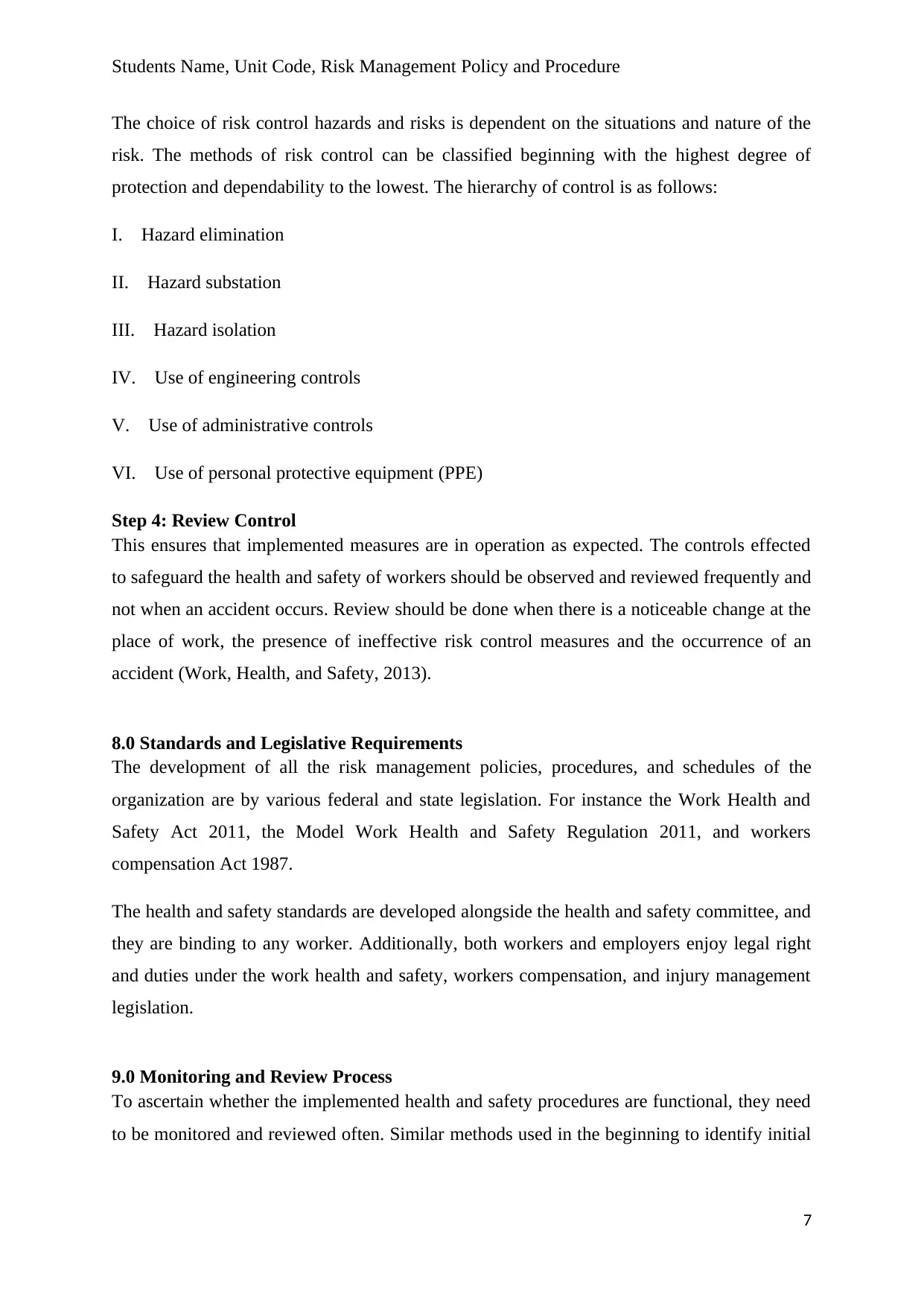
Students Name, Unit Code, Risk Management Policy and Procedure
The choice of risk control hazards and risks is dependent on the situations and nature of the
risk. The methods of risk control can be classified beginning with the highest degree of
protection and dependability to the lowest. The hierarchy of control is as follows:
I. Hazard elimination
II. Hazard substation
III. Hazard isolation
IV. Use of engineering controls
V. Use of administrative controls
VI. Use of personal protective equipment (PPE)
Step 4: Review Control
This ensures that implemented measures are in operation as expected. The controls effected
to safeguard the health and safety of workers should be observed and reviewed frequently and
not when an accident occurs. Review should be done when there is a noticeable change at the
place of work, the presence of ineffective risk control measures and the occurrence of an
accident (Work, Health, and Safety, 2013).
8.0 Standards and Legislative Requirements
The development of all the risk management policies, procedures, and schedules of the
organization are by various federal and state legislation. For instance the Work Health and
Safety Act 2011, the Model Work Health and Safety Regulation 2011, and workers
compensation Act 1987.
The health and safety standards are developed alongside the health and safety committee, and
they are binding to any worker. Additionally, both workers and employers enjoy legal right
and duties under the work health and safety, workers compensation, and injury management
legislation.
9.0 Monitoring and Review Process
To ascertain whether the implemented health and safety procedures are functional, they need
to be monitored and reviewed often. Similar methods used in the beginning to identify initial
7
The choice of risk control hazards and risks is dependent on the situations and nature of the
risk. The methods of risk control can be classified beginning with the highest degree of
protection and dependability to the lowest. The hierarchy of control is as follows:
I. Hazard elimination
II. Hazard substation
III. Hazard isolation
IV. Use of engineering controls
V. Use of administrative controls
VI. Use of personal protective equipment (PPE)
Step 4: Review Control
This ensures that implemented measures are in operation as expected. The controls effected
to safeguard the health and safety of workers should be observed and reviewed frequently and
not when an accident occurs. Review should be done when there is a noticeable change at the
place of work, the presence of ineffective risk control measures and the occurrence of an
accident (Work, Health, and Safety, 2013).
8.0 Standards and Legislative Requirements
The development of all the risk management policies, procedures, and schedules of the
organization are by various federal and state legislation. For instance the Work Health and
Safety Act 2011, the Model Work Health and Safety Regulation 2011, and workers
compensation Act 1987.
The health and safety standards are developed alongside the health and safety committee, and
they are binding to any worker. Additionally, both workers and employers enjoy legal right
and duties under the work health and safety, workers compensation, and injury management
legislation.
9.0 Monitoring and Review Process
To ascertain whether the implemented health and safety procedures are functional, they need
to be monitored and reviewed often. Similar methods used in the beginning to identify initial
7
Paraphrase This Document
Need a fresh take? Get an instant paraphrase of this document with our AI Paraphraser
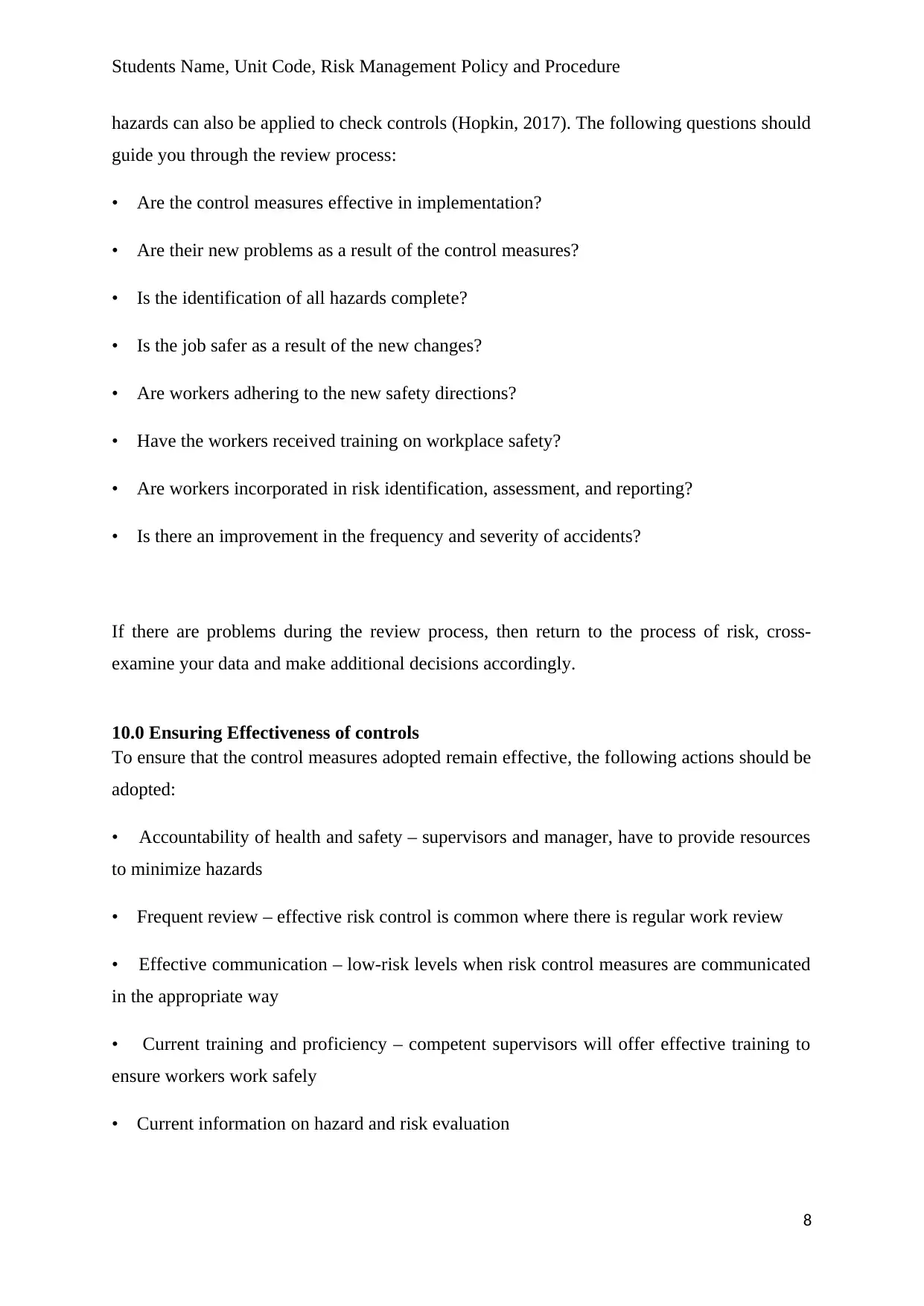
Students Name, Unit Code, Risk Management Policy and Procedure
hazards can also be applied to check controls (Hopkin, 2017). The following questions should
guide you through the review process:
• Are the control measures effective in implementation?
• Are their new problems as a result of the control measures?
• Is the identification of all hazards complete?
• Is the job safer as a result of the new changes?
• Are workers adhering to the new safety directions?
• Have the workers received training on workplace safety?
• Are workers incorporated in risk identification, assessment, and reporting?
• Is there an improvement in the frequency and severity of accidents?
If there are problems during the review process, then return to the process of risk, cross-
examine your data and make additional decisions accordingly.
10.0 Ensuring Effectiveness of controls
To ensure that the control measures adopted remain effective, the following actions should be
adopted:
• Accountability of health and safety – supervisors and manager, have to provide resources
to minimize hazards
• Frequent review – effective risk control is common where there is regular work review
• Effective communication – low-risk levels when risk control measures are communicated
in the appropriate way
• Current training and proficiency – competent supervisors will offer effective training to
ensure workers work safely
• Current information on hazard and risk evaluation
8
hazards can also be applied to check controls (Hopkin, 2017). The following questions should
guide you through the review process:
• Are the control measures effective in implementation?
• Are their new problems as a result of the control measures?
• Is the identification of all hazards complete?
• Is the job safer as a result of the new changes?
• Are workers adhering to the new safety directions?
• Have the workers received training on workplace safety?
• Are workers incorporated in risk identification, assessment, and reporting?
• Is there an improvement in the frequency and severity of accidents?
If there are problems during the review process, then return to the process of risk, cross-
examine your data and make additional decisions accordingly.
10.0 Ensuring Effectiveness of controls
To ensure that the control measures adopted remain effective, the following actions should be
adopted:
• Accountability of health and safety – supervisors and manager, have to provide resources
to minimize hazards
• Frequent review – effective risk control is common where there is regular work review
• Effective communication – low-risk levels when risk control measures are communicated
in the appropriate way
• Current training and proficiency – competent supervisors will offer effective training to
ensure workers work safely
• Current information on hazard and risk evaluation
8
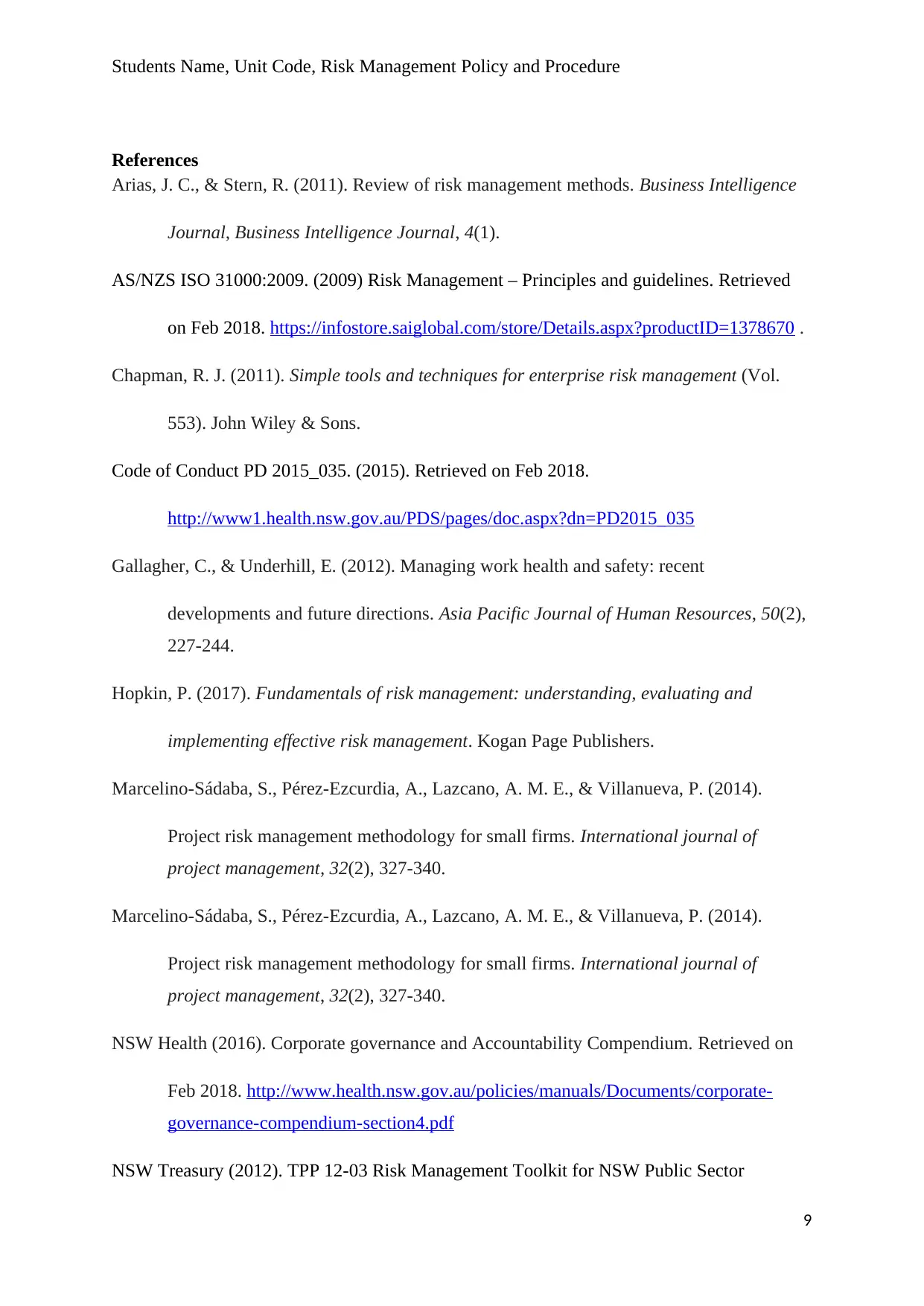
Students Name, Unit Code, Risk Management Policy and Procedure
References
Arias, J. C., & Stern, R. (2011). Review of risk management methods. Business Intelligence
Journal, Business Intelligence Journal, 4(1).
AS/NZS ISO 31000:2009. (2009) Risk Management – Principles and guidelines. Retrieved
on Feb 2018. https://infostore.saiglobal.com/store/Details.aspx?productID=1378670 .
Chapman, R. J. (2011). Simple tools and techniques for enterprise risk management (Vol.
553). John Wiley & Sons.
Code of Conduct PD 2015_035. (2015). Retrieved on Feb 2018.
http://www1.health.nsw.gov.au/PDS/pages/doc.aspx?dn=PD2015_035
Gallagher, C., & Underhill, E. (2012). Managing work health and safety: recent
developments and future directions. Asia Pacific Journal of Human Resources, 50(2),
227-244.
Hopkin, P. (2017). Fundamentals of risk management: understanding, evaluating and
implementing effective risk management. Kogan Page Publishers.
Marcelino-Sádaba, S., Pérez-Ezcurdia, A., Lazcano, A. M. E., & Villanueva, P. (2014).
Project risk management methodology for small firms. International journal of
project management, 32(2), 327-340.
Marcelino-Sádaba, S., Pérez-Ezcurdia, A., Lazcano, A. M. E., & Villanueva, P. (2014).
Project risk management methodology for small firms. International journal of
project management, 32(2), 327-340.
NSW Health (2016). Corporate governance and Accountability Compendium. Retrieved on
Feb 2018. http://www.health.nsw.gov.au/policies/manuals/Documents/corporate-
governance-compendium-section4.pdf
NSW Treasury (2012). TPP 12-03 Risk Management Toolkit for NSW Public Sector
9
References
Arias, J. C., & Stern, R. (2011). Review of risk management methods. Business Intelligence
Journal, Business Intelligence Journal, 4(1).
AS/NZS ISO 31000:2009. (2009) Risk Management – Principles and guidelines. Retrieved
on Feb 2018. https://infostore.saiglobal.com/store/Details.aspx?productID=1378670 .
Chapman, R. J. (2011). Simple tools and techniques for enterprise risk management (Vol.
553). John Wiley & Sons.
Code of Conduct PD 2015_035. (2015). Retrieved on Feb 2018.
http://www1.health.nsw.gov.au/PDS/pages/doc.aspx?dn=PD2015_035
Gallagher, C., & Underhill, E. (2012). Managing work health and safety: recent
developments and future directions. Asia Pacific Journal of Human Resources, 50(2),
227-244.
Hopkin, P. (2017). Fundamentals of risk management: understanding, evaluating and
implementing effective risk management. Kogan Page Publishers.
Marcelino-Sádaba, S., Pérez-Ezcurdia, A., Lazcano, A. M. E., & Villanueva, P. (2014).
Project risk management methodology for small firms. International journal of
project management, 32(2), 327-340.
Marcelino-Sádaba, S., Pérez-Ezcurdia, A., Lazcano, A. M. E., & Villanueva, P. (2014).
Project risk management methodology for small firms. International journal of
project management, 32(2), 327-340.
NSW Health (2016). Corporate governance and Accountability Compendium. Retrieved on
Feb 2018. http://www.health.nsw.gov.au/policies/manuals/Documents/corporate-
governance-compendium-section4.pdf
NSW Treasury (2012). TPP 12-03 Risk Management Toolkit for NSW Public Sector
9
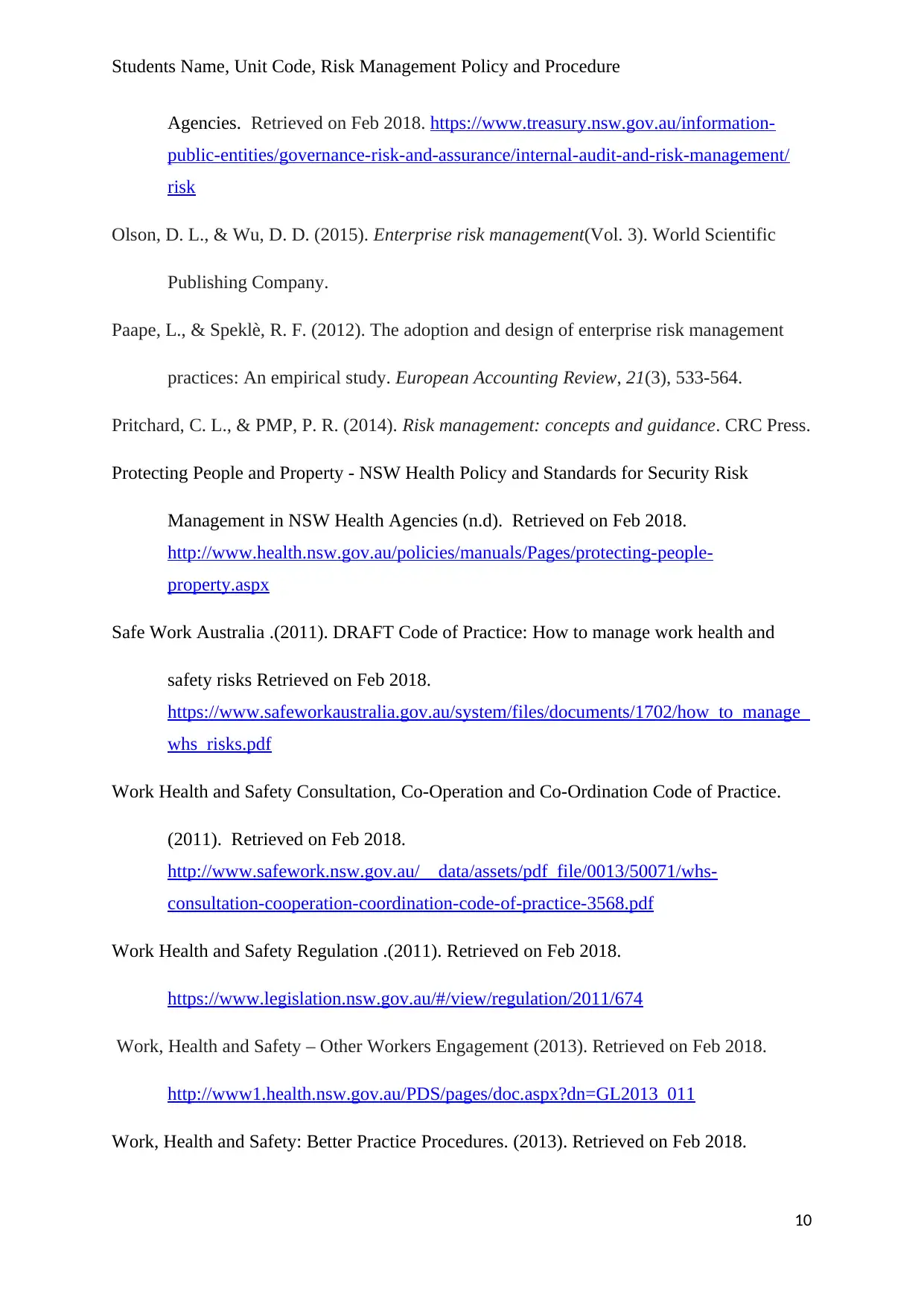
Students Name, Unit Code, Risk Management Policy and Procedure
Agencies. Retrieved on Feb 2018. https://www.treasury.nsw.gov.au/information-
public-entities/governance-risk-and-assurance/internal-audit-and-risk-management/
risk
Olson, D. L., & Wu, D. D. (2015). Enterprise risk management(Vol. 3). World Scientific
Publishing Company.
Paape, L., & Speklè, R. F. (2012). The adoption and design of enterprise risk management
practices: An empirical study. European Accounting Review, 21(3), 533-564.
Pritchard, C. L., & PMP, P. R. (2014). Risk management: concepts and guidance. CRC Press.
Protecting People and Property - NSW Health Policy and Standards for Security Risk
Management in NSW Health Agencies (n.d). Retrieved on Feb 2018.
http://www.health.nsw.gov.au/policies/manuals/Pages/protecting-people-
property.aspx
Safe Work Australia .(2011). DRAFT Code of Practice: How to manage work health and
safety risks Retrieved on Feb 2018.
https://www.safeworkaustralia.gov.au/system/files/documents/1702/how_to_manage_
whs_risks.pdf
Work Health and Safety Consultation, Co-Operation and Co-Ordination Code of Practice.
(2011). Retrieved on Feb 2018.
http://www.safework.nsw.gov.au/__data/assets/pdf_file/0013/50071/whs-
consultation-cooperation-coordination-code-of-practice-3568.pdf
Work Health and Safety Regulation .(2011). Retrieved on Feb 2018.
https://www.legislation.nsw.gov.au/#/view/regulation/2011/674
Work, Health and Safety – Other Workers Engagement (2013). Retrieved on Feb 2018.
http://www1.health.nsw.gov.au/PDS/pages/doc.aspx?dn=GL2013_011
Work, Health and Safety: Better Practice Procedures. (2013). Retrieved on Feb 2018.
10
Agencies. Retrieved on Feb 2018. https://www.treasury.nsw.gov.au/information-
public-entities/governance-risk-and-assurance/internal-audit-and-risk-management/
risk
Olson, D. L., & Wu, D. D. (2015). Enterprise risk management(Vol. 3). World Scientific
Publishing Company.
Paape, L., & Speklè, R. F. (2012). The adoption and design of enterprise risk management
practices: An empirical study. European Accounting Review, 21(3), 533-564.
Pritchard, C. L., & PMP, P. R. (2014). Risk management: concepts and guidance. CRC Press.
Protecting People and Property - NSW Health Policy and Standards for Security Risk
Management in NSW Health Agencies (n.d). Retrieved on Feb 2018.
http://www.health.nsw.gov.au/policies/manuals/Pages/protecting-people-
property.aspx
Safe Work Australia .(2011). DRAFT Code of Practice: How to manage work health and
safety risks Retrieved on Feb 2018.
https://www.safeworkaustralia.gov.au/system/files/documents/1702/how_to_manage_
whs_risks.pdf
Work Health and Safety Consultation, Co-Operation and Co-Ordination Code of Practice.
(2011). Retrieved on Feb 2018.
http://www.safework.nsw.gov.au/__data/assets/pdf_file/0013/50071/whs-
consultation-cooperation-coordination-code-of-practice-3568.pdf
Work Health and Safety Regulation .(2011). Retrieved on Feb 2018.
https://www.legislation.nsw.gov.au/#/view/regulation/2011/674
Work, Health and Safety – Other Workers Engagement (2013). Retrieved on Feb 2018.
http://www1.health.nsw.gov.au/PDS/pages/doc.aspx?dn=GL2013_011
Work, Health and Safety: Better Practice Procedures. (2013). Retrieved on Feb 2018.
10
Secure Best Marks with AI Grader
Need help grading? Try our AI Grader for instant feedback on your assignments.

Students Name, Unit Code, Risk Management Policy and Procedure
http://www1.health.nsw.gov.au/PDS/pages/doc.aspx?dn=PD2013_005
11
http://www1.health.nsw.gov.au/PDS/pages/doc.aspx?dn=PD2013_005
11
1 out of 11
Related Documents
Your All-in-One AI-Powered Toolkit for Academic Success.
+13062052269
info@desklib.com
Available 24*7 on WhatsApp / Email
![[object Object]](/_next/static/media/star-bottom.7253800d.svg)
Unlock your academic potential
© 2024 | Zucol Services PVT LTD | All rights reserved.





